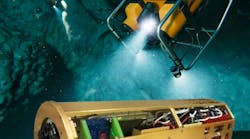ARLINGTON, Va. – U.S. military researchers are moving forward with a project to develop enabling technologies for future large-size unmanned underwater vehicles (UUVs) with long endurance and large payload capacity.
Officials of the U.S. Defense Advanced Research Projects Agency (DARPA) in Arlington, Va., announced a $41.2 million contract in December to the Northrop Grumman Mission Systems segment in Linthicum, Md., for phase two of the Manta Ray program.
Manta Ray is to open a design space for future long-endurance unmanned submersibles that are capable of long-duration missions and large payload capacity, as well as to advance key technologies that will benefit other naval designs such as low-cost UUV operations, long duration undersea power management, biofouling reduction, and long-duration navigation.
Northrop Grumman was among Manta Ray phase-one contractors, which included Lockheed Martin Corp., Martin Defense Group, and Navatek LLC. Martin Defense in Honolulu won a $54.8 million contract in September for the second phase of the Manta Ray project.
Related: Military research projects may be coming together to put large long-endurance UUVs in sight
The program is developing enabling technologies in energy management and harvesting; low-power high-efficiency propulsion; efficient navigation; mission management; command, control, and communications during long-duration deployments; and techniques to mitigate biofouling, corrosion, and other material degradation.
Phase one was to develop enabling technologies and subsystems for the future Manta Ray large UUV, and phase two focuses on systems integration, based on overall risk posture, maturity of critical subsystems, and technical performance. The future third phase also will involve early testing to reduce program risk, as well as integration testing of Manta Ray energy-management techniques.
UUVs that operate for extended durations without the need for logistic support or maintenance from humans offer the potential for persistent operations in forward environments, DARPA officials explain. Such systems could enhance the flexibility of traditional manned host vessels by providing servicing ports and reduced workloads, officials say.
The Manta Ray program seeks to demonstrate critical technologies for a new class of long-duration, long-range, payload-capable UUVs to give extra capacity to military commanders without disrupting their operations. Key aspects of the Manta Ray program are classified.
The Manta Ray program seeks to develop key technologies in energy management for UUV operations; energy harvesting at submerged depths; low-power and high efficiency undersea propulsion; and low-power underwater detection and classification of hazards or counter detection threats.
Manta Ray also will investigate mission-management technologies for extended UUV operations; high-efficiency undersea navigation; and new ways to mitigate biofouling, corrosion, and other material degradation for long-duration missions.
The Manta Ray project will includes at-sea demonstration of critical technologies to define program goals and identify enabling technologies necessary for future systems.
On this Manta Ray phase-two contract, Northrop Grumman will do the work in Linthicum and Baltimore, Md.; Woods Hole, Mass.; Grandview, Mo.; North Kingstown, R.I.; and Gulfport, Miss., and should be finished by December 2023.
For more information contact Northrop Grumman Mission Systems online at www.northropgrumman.com, Martin Defense Group online at https://mdefensegroup.com, or DARPA at www.darpa.mil/program/manta-ray.



